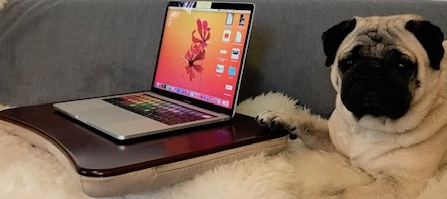
This blog posts on Mondays. Second Mondays of the month I devote to my writing workshop students and anyone else interested in creative writing. Welcome!
> For the archive of workshop posts click here.

As far as the need for equipment goes, writing is not like casting bronze sculpture. All you need is a pencil and paper–any scrap will do. The formidable challenge most writers face is managing their attentional focus, that is to say, their ability to actually sit down and, ahem, actually write.
Sheer willpower isn’t the only thing needed, however. Habits, even tiny habits, can help enormously. Here’s where some writerly material tools can be useful… perhaps. I say “perhaps” because what works for one writer may not necessarily work for another.
What do I mean by “writerly material tools”? Well, you could have a special pencil and make a ritual of sharpening your special pencil– so there you have a pencil, and you have a pencil sharpener. Not a budget buster. If you don’t know what to do with your money, why, you could go gung-ho for such writerly material tools as a gold-plated typewriter with your name engraved in curlicues or, say, some rococo-rama iteration of George Bernard Shaw’s rotating writing shed.
What works for me? Sometimes I write with a pencil and paper but generally I am at my desk with my laptop or, perchance, my typewriter. But for a spell each and every morning I also use a lap desk, which enables me to turn my office sofa– a big sloppy boat of a sofa with two pugs inevitably snoring through their post-breakfast siestas– into another workspace.
A lap desk has its limits, obviously: It holds the laptop, or a pencil and paper, that’s it. But for certain writing endeavors, it enables me to remove myself to a different working space, as needed, and so clear my mind, the better to focus on the task at-hand.
If you want to try using a lap desk you don’t necessarily need to buy one. A cookie pan balanced over a pillow would work just as well.
Where in your house is there a comfortable spot to sit where you don’t normally? Maybe that could be the place you take your lap desk every morning, or every evening, instead of, say, scrolling through the news or social media feeds on the smartphone, or plunking yourself in front that bigger screen.
What for? Well, do you feel stuck with your novel? Or memoir? Might you try flexing your creative mojo with 10 minutes of writing exercises? Or 15 minutes of journaling?
How about just catching up on personal correspondence? (I would argue that email is a vital for writers.)
Some writers claim that it helps to do their financial paperwork in a different place than their creative work– so you could try doing one at your lap desk, the other at your regular desk, or kitchen table, or library carrel– or wherever it is for you.
There are of course infinite ways to slice & dice & spice one’s writing time and routines. Again, what works for one writer may or may not for another.
My point is, my experience has been that it helps to corral a convenient alternative writing place for a specific time and specific writerly purpose, and a lap desk, bingo, turns any number of places into possibilities, from the bed to the sofa to the floor to the balcony, the garden….
P.S. In his writing shed Roald Dahl used a custom-made writing board covered in felt.

Working with a Working Library: Kuddelmuddel
Book Review:
Richard Parker’s Lone Star Nation: How Texas Will Transform America
From the Typosphere: “Right” and “Wrong”
Find out more about C.M. Mayo’s books, shorter works, podcasts, and more at www.cmmayo.com.

